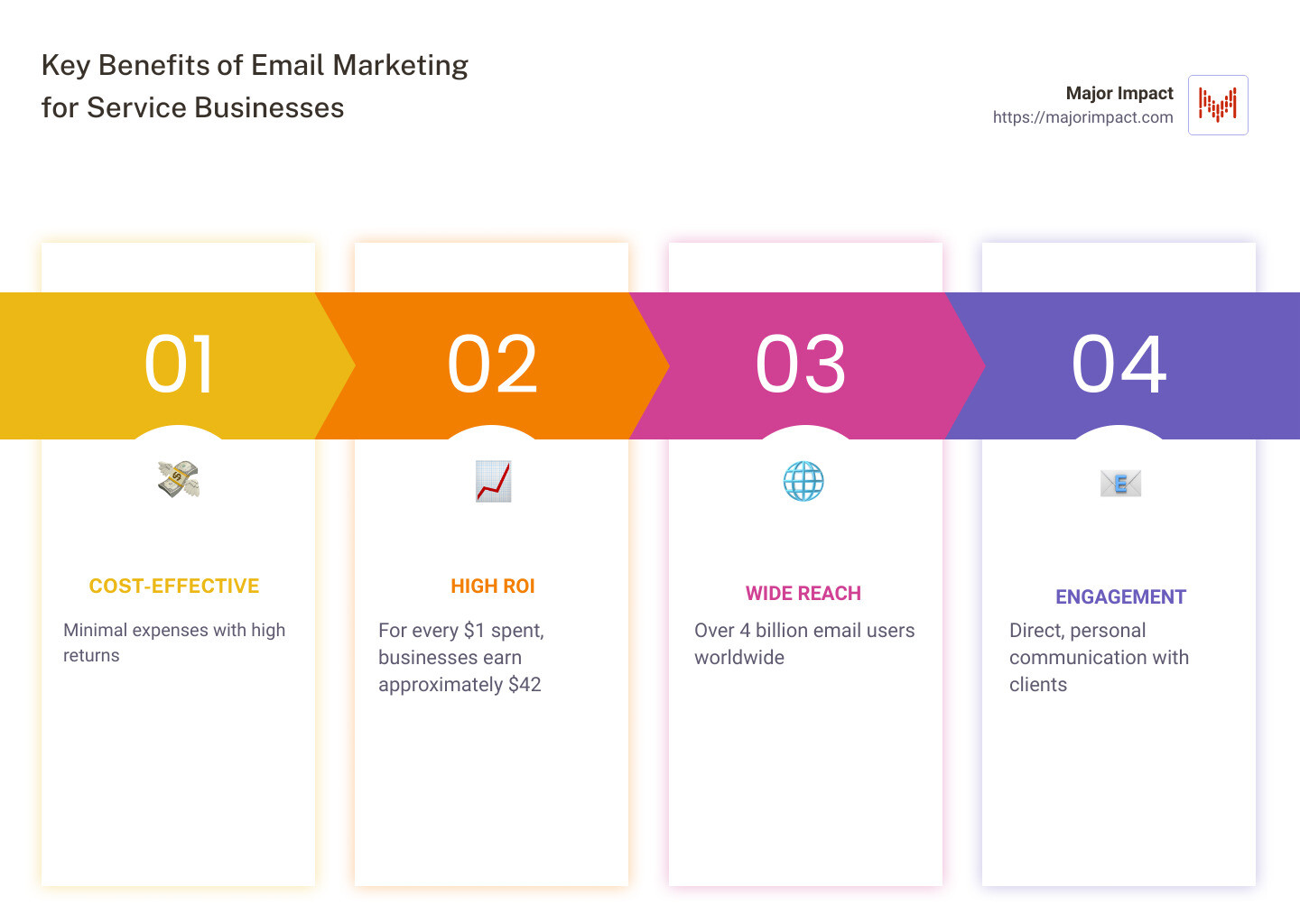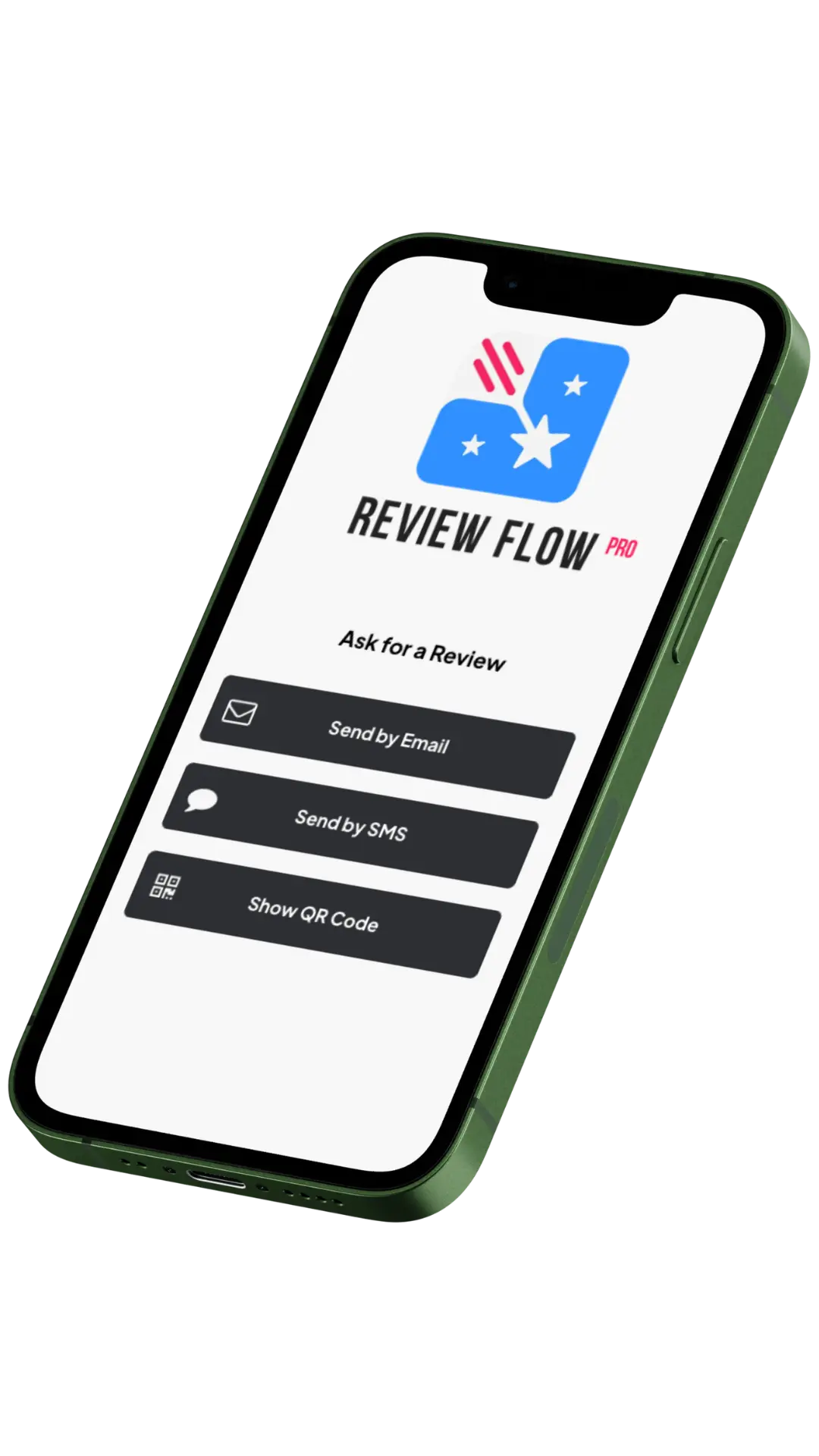Table of Contents
Introduction
Email marketing, for service businesses, is one of the most effective digital marketing strategies you can use today. It’s cost-effective, boasts high returns on investment (ROI), and is perfect for businesses of all sizes looking to increase traffic, generate leads, and boost sales.
Key Benefits of Email Marketing for Service Businesses:
- Cost-Effective: Minimal expenses with high returns.
- High ROI: For every $1 spent, businesses earn approximately $42.
- Wide Reach: Over 4 billion email users worldwide.
- Engagement: Direct, personal communication with clients.
When digital communication is king, targeting your audience through email allows you to build lasting relationships, leading to loyal, repeat customers. Whether you’re a beauty salon, fitness coach, or cleaning company, a well-strategized email campaign can drive traffic and generate significant leads.
Why Email Marketing for Service Businesses?
Email marketing is a powerful tool for service businesses. It’s not just about sending emails; it’s about building relationships, engaging customers, and driving sales. Here’s why email marketing is a game-changer for your service business:
Cost-Effective
One of the biggest advantages of email marketing is its affordability. Compared to other digital marketing methods, email marketing offers a high return on investment (ROI). According to Litmus, for every $1 spent, email marketing generates an average ROI of $36. This makes it an excellent choice for businesses with tight budgets looking to make a significant impact.
High ROI
The ROI for email marketing is impressive. A study by Statista showed that the number of email users is expected to grow to 4.6 billion by 2025. With such a vast audience, the potential for reaching new customers and increasing sales is enormous. For service businesses, this means more appointments, more bookings, and ultimately, more revenue.
Customer Engagement
Emails are a direct line to your customers. They allow you to communicate one-on-one, share updates, and offer personalized content. This level of engagement is hard to achieve with other forms of marketing. Personalized emails can make customers feel valued and understood, increasing their loyalty to your brand.
For example, a beauty salon could send personalized appointment reminders and special offers to regular clients, enhancing their overall experience and encouraging repeat visits.
Brand Awareness
Email marketing helps keep your brand top-of-mind. Regular communication with your subscribers ensures they remember your business when they need your services. Think of it as an ongoing conversation that builds trust and familiarity over time. This is crucial for service businesses where trust and reliability are key factors in customer decisions.
Real-Life Example
Consider a cleaning company using email marketing to send out seasonal offers and tips for maintaining a clean home. By consistently providing value, they stay relevant to their customers’ needs. When it’s time for a deep clean, their brand is the first that comes to mind.
Next, we’ll dive into Building Your Email List and how to effectively gather and segment your audience for maximum impact.
Building Your Email List
Building an effective email list is the bedrock of successful email marketing for service businesses. Here’s how to get started:
Opt-In Forms
Adding opt-in forms to your website is essential. These forms invite visitors to subscribe to your mailing list. They can be placed in pop-ups, sidebars, or at the end of blog posts. Ensure they are easy to find and fill out.
Pro Tip: Use a compelling call-to-action (CTA) like “Get Free Gardening Tips!” to attract more sign-ups.
Social Media
If your business has a social media presence, leverage it to grow your email list. Promote your newsletter on platforms like Facebook, Instagram, and Twitter. Your followers are already engaged with your brand, making them more likely to subscribe.
Example: A gardening service could post, “Follow us for exclusive gardening tips straight to your inbox! Sign up now!”
Incentives for Signing Up
People are more likely to join your email list if there’s something in it for them. Offer incentives like free ebooks, discount coupons, or exclusive content.
Case Study: A financial advisory firm saw a 30% increase in sign-ups after offering a free personal finance ebook.
Segmenting Your Audience
Once you have a growing list, the next step is segmentation. This means dividing your audience into smaller groups based on specific criteria. Segmentation allows you to send more personalized and relevant emails.
Zip Code
Segmenting by zip code is useful for localized promotions. For example, a home improvement service can send targeted offers to subscribers in specific neighborhoods.
Age
Age segmentation helps tailor content to different life stages. A financial advisor might send retirement planning tips to older subscribers and student loan advice to younger ones.
Membership Status
Identify subscribers who are members or have special status. Offering exclusive deals to loyal customers can improve retention rates.
Last Service Date
Track the last service date to send timely follow-ups. For instance, an HVAC service can remind customers about seasonal maintenance.
Example: “It’s been a year since your last HVAC check-up. Schedule your service now and enjoy a 10% discount!”
By focusing on these strategies, you can build a robust and segmented email list, setting the stage for effective email marketing campaigns.
Next, we’ll explore Crafting Effective Emails and how to create content that keeps your audience engaged.
Crafting Effective Emails
Once you have a segmented email list, the next step is to craft emails that resonate with your audience. Effective emails don’t just inform—they engage, persuade, and convert. Here’s how you can make your emails stand out.
Creating Catchy Subject Lines
Your subject line is the first impression. It determines whether your email gets opened or ignored. Here are some key strategies to craft subject lines that grab attention:
- Avoid spam triggers: Words like “Free,” “Buy now,” or multiple exclamation points can send your email straight to the spam folder.
- Create urgency: Use deadlines to motivate quick action. For example, “Fall tune-up special ends tomorrow!”.
- Ask questions: Engage curiosity with questions like, “Is your home winter-ready?”
- Keep it short: Aim for 50 characters or less. Most people read emails on their phones, so get to the point quickly.
Example: “Top 5 ways to improve energy efficiency in your home”
Designing Professional Emails
A well-designed email builds trust and improves readability. Here’s how to make your emails look sharp and professional:
- Use templates: Email marketing platforms like Mailchimp offer templates that are easy to customize.
- Maintain brand consistency: Use your brand colors, fonts, and logo to make your emails instantly recognizable.
- Ensure mobile-friendliness: Over 75% of emails are opened on mobile devices. Make sure your design looks good on all screen sizes.
Example: Use a clean, uncluttered layout with clear headings and a single call-to-action (CTA).
Personalization
Personalized emails perform better. Use your customer data to make each email feel unique:
- Address recipients by name: “Hi John,” feels more personal than “Dear Customer.”
- Tailor content to their interests: If a customer recently bought a new HVAC system, send them maintenance tips.
Statistic: Emails with personalized subject lines are 26% more likely to be opened.
Adding Value to Every Email
Your emails should always offer something valuable. This could be tips, exclusive content, or special offers:
- Educational content: Share your expertise. For instance, a plumbing service could send tips on preventing winter pipe bursts.
- Exclusive offers: Reward your subscribers with special discounts or early access to sales.
Case Study: Landcafe.pl increased their sales rate by 41.30% through educational welcome emails.
Avoiding Spam Triggers
To ensure your emails land in the inbox, avoid common spam triggers:
- No all caps: Emails in all caps look like shouting and often get flagged.
- No misleading subject lines: Stay honest and relevant to avoid being marked as spam.
Example: Instead of “FREE!!! Save Big Money Now!!!”, try “Exclusive 10% Discount for Our Valued Customers.”
By following these steps, you can craft effective emails that not only get opened but also drive engagement and conversions.
Next, we’ll dive into the different Types of Email Campaigns you can use to keep your audience engaged and drive results.
Types of Email Campaigns
Newsletters
Newsletters are a great way to keep your customers informed and engaged. They can include updates about your business, industry news, tips, and promotions. For example, a mental health therapy company might send a weekly newsletter with wellness tips and information about upcoming workshops.
Key Tips for Newsletters:
– Consistency: Send newsletters on a regular schedule (weekly, bi-weekly, or monthly).
– Value: Provide useful information that your audience will appreciate.
– Personalization: Use the recipient’s name and tailor content to their interests.
Promotional Emails
Promotional emails are designed to drive sales and conversions. They often highlight special offers, discounts, or new services. For instance, a plumbing service might send an email offering a 10% discount on emergency services during the winter months.
Effective Promotional Email Strategies:
– Limited-Time Offers: Create urgency by offering discounts or deals that are available for a short period.
– Special Discounts: Reward loyal customers with exclusive discounts.
– Vendor Campaigns: Partner with vendors to promote products like smart thermostats using their high-quality images and marketing collateral.
Transactional Emails
Transactional emails are triggered by a customer’s action. These can include order confirmations, appointment reminders, or membership renewal notices. They are crucial for maintaining clear communication and building trust.
Examples of Transactional Emails:
– Order Confirmations: Send an email confirming a service booking or product purchase.
– Appointment Reminders: Remind customers of upcoming appointments to reduce no-shows.
– Membership Renewals: Notify customers when their memberships are about to expire and encourage renewal.
Seasonal Campaigns
Seasonal campaigns leverage timely events to engage customers. These can be tied to holidays, weather events, or anniversaries.
Thanksgiving “Brown Friday”
The day after Thanksgiving, known as “Brown Friday,” is the busiest day of the year for plumbers due to clogged sinks and garbage disposals. Send a pre-Thanksgiving email with tips to avoid clogs, followed by a “Brown Friday” email offering emergency services.
Severe Weather Campaigns
If a big storm is approaching, send an email offering consultations for whole-house generators or discounts on surge protection. Target customers in affected zip codes to maximize relevance.
Anniversary Campaigns
Celebrate your business anniversary by offering special promotions or discounts. This not only rewards loyal customers but also attracts new ones.
Additional Seasonal Campaign Ideas:
– Holiday Offers: Christmas, New Year, and other holidays are perfect for special promotions.
– Back-to-School: Offer discounts on services that parents might need during the busy back-to-school season.
By incorporating these types of email campaigns into your marketing strategy, you can keep your audience engaged, drive traffic, and boost sales.
Next, we’ll explore how to Automate Your Email Marketing to save time and ensure that no opportunity is missed.
Automating Your Email Marketing
Email automation can save you time and ensure no opportunity is missed. Here’s how to get started with automating your email marketing for service businesses.
Email Automation Tools
Using the right tools is crucial for effective email automation. Tools like Mailchimp, Constant Contact, and ServiceTitan Marketing Pro offer robust features tailored for service-based businesses. These tools help you:
- Schedule Emails: Plan and send emails at optimal times.
- Segment Lists: Target specific groups based on behavior or demographics.
- Track Performance: Monitor open rates, click-through rates, and conversions.
Follow-Ups and Reminders
Automated follow-ups and reminders can help you close more business. For instance, if a customer received an estimate but hasn’t moved forward, an automated follow-up can remind them of the benefits and offer a discount to incentivize action.
Example: A homeowner receives an estimate for a water heater replacement. If they don’t act immediately, an automated sequence of emails can remind them of the importance of changing their water heater and offer a discount to close the sale.
ServiceTitan Marketing Pro
ServiceTitan Marketing Pro is designed specifically for home service companies. It allows you to:
- Hypertarget Your Audience: Use the data already in ServiceTitan to create targeted campaigns.
- Automate Emails: Set up automated sequences for follow-ups, reminders, and promotions.
- Analyze ROI: Review the return on investment for your campaigns.
Case Study: Many home service businesses using ServiceTitan have seen a 25% increase in revenue within their first year. This is due to the platform’s ability to streamline operations and automate marketing efforts effectively.
Benefits of Automation
- Time-Saving: Automation frees up time, allowing you to focus on other aspects of your business.
- Consistency: Ensure consistent communication with your clients.
- Higher Engagement: Automated emails are timely and relevant, leading to higher open and click-through rates.
By automating your email marketing, you can ensure that you never miss an opportunity to engage with your customers and drive more revenue.
Next, we’ll look at Analyzing and Optimizing Your Campaigns to maximize your email marketing efforts.
Analyzing and Optimizing Your Campaigns
Analyzing and optimizing your email marketing campaigns is crucial for maximizing engagement and conversions. Here are the key metrics and techniques to focus on:
Open Rates
Open rate is the percentage of recipients who open your email. A high open rate indicates that your subject line and sender name are compelling. According to CampaignMonitor, a good open rate is between 17% and 28%.
Tips to improve open rates:
– Personalize subject lines: Use the recipient’s name.
– Create urgency: Highlight limited-time offers.
– Use emojis: They add a fun element and can increase open rates by 56%.
Click-Through Rates (CTR)
Click-through rate (CTR) is the percentage of recipients who clicked on a link within your email. This metric shows how engaging your content and CTAs (calls-to-action) are. A good CTR is around 2% to 5%.
Tips to improve CTR:
– Clear CTAs: Make your call-to-action buttons stand out.
– Engaging content: Provide value with tips, news, or offers.
– Mobile-friendly design: Ensure your emails are easy to navigate on mobile devices.
Conversion Rates
Conversion rate is the percentage of recipients who completed a desired action, such as booking a service or making a purchase. Aim for a 2% to 5% conversion rate.
Tips to improve conversion rates:
– Compelling value propositions: Clearly state the benefits of your service.
– Social proof: Include testimonials or case studies.
– Follow-up sequences: Send multiple emails to nurture leads.
A/B Testing
A/B testing allows you to compare two versions of an email to see which performs better. This can help you optimize various elements like subject lines, images, and CTAs.
How to run an A/B test:
1. Create two versions: Change one element, such as the subject line.
2. Segment your audience: Split your email list into two groups.
3. Send and analyze: Send each version to a different group and analyze the results.
4. Optimize: Use the winning version for future campaigns.
Example: A home service business tested two subject lines: “Get 20% Off Your Next Service” vs. “Limited-Time Offer: 20% Off!” The second subject line resulted in a 15% higher open rate.
By monitoring these metrics and continuously optimizing your campaigns, you can significantly improve your email marketing effectiveness. For a detailed analysis of your email marketing performance, consider using tools like Mailchimp or Zoho Campaigns.
Next, we’ll answer some Frequently Asked Questions about Email Marketing for Service Businesses.
Frequently Asked Questions about Email Marketing for Service Businesses
How to market services through email?
Marketing services through email can be incredibly effective if done correctly. Here are the steps to get started:
- Define Your Audience: Understanding who your target audience is will help you tailor your messages. For instance, if you offer gardening services, you’ll want to target homeowners with gardens, not apartment dwellers.
- Set Goals: Determine what you want to achieve with your email campaigns. Are you looking to generate leads, increase sales, or build brand awareness?
- Choose a Platform: Select an email marketing platform that suits your needs. Popular choices include Mailchimp and Constant Contact.
- Build Your List: Use opt-in forms on your website, social media, and other channels to collect email addresses. Offering incentives like discounts or free guides can help grow your list quickly.
- Segment Your List: Divide your email list into smaller segments based on specific criteria like location, past purchase behavior, or service type. This allows for more personalized and effective emails.
- Create Your Email: Craft emails that are engaging and valuable to your audience. Include tips, news, or special offers relevant to their interests.
- Test Your Email: Before sending out your email, test it to make sure it looks good on different devices and email clients. A/B testing different elements like subject lines can also help optimize performance.
How do I sell my services via email?
Selling services via email requires a strategic approach. Here’s how you can do it:
- Compelling Subject Line: Your subject line is the first thing recipients see, so make it catchy and relevant. Avoid spammy words and keep it short.
Example: Instead of “Amazing Deals!”, try “John, Save 20% on Your Next Plumbing Service!”
- Address Pain Points: Identify and address the specific problems your audience faces. Show how your services can solve these issues.
- Highlight Value Proposition: Clearly explain the benefits of your services. What makes your service unique or better than the competition?
- Social Proof: Include testimonials, case studies, or reviews from satisfied customers to build trust.
- Clear CTA: Have a clear call-to-action (CTA) that guides the reader on what to do next, whether it’s booking a service, calling for a consultation, or visiting your website.
How do I legally send marketing emails?
Compliance with email marketing laws is crucial to avoid penalties and maintain trust with your audience. Here’s what you need to do:
- Opt-In: Ensure that recipients have given explicit consent to receive emails from you. Use opt-in forms on your website or landing pages.
- Store Consent: Keep records of how and when each subscriber gave their consent. This is important for compliance with regulations like GDPR.
- Offer Opt-Out: Always include an easy way for recipients to unsubscribe from your emails. This is not just good practice but a legal requirement under laws like CAN-SPAM.
- Follow Regulations: Familiarize yourself with and adhere to email marketing laws applicable to your region, such as GDPR in Europe or CAN-SPAM in the United States.
By following these steps, you can create effective and compliant email marketing campaigns that drive results for your service-based business.
Conclusion
Email marketing for service businesses is a powerful tool that can significantly elevate your marketing strategy. With the right approach, it can boost traffic, generate leads, and ultimately increase sales.
By integrating email marketing into your overall strategy, you can maintain consistent engagement with your customers. This not only enhances brand awareness but also fosters long-term relationships that translate into repeat business and referrals.
Here’s a quick recap of what you need to do:
- Build and Segment Your Email List: Use opt-in forms, social media, and incentives to grow your list. Segment your audience to tailor your messages effectively.
- Craft Effective Emails: Personalize your content, create catchy subject lines, and ensure your emails are visually appealing and mobile-friendly.
- Automate Your Campaigns: Utilize email automation tools to streamline follow-ups and reminders, making your marketing efforts more efficient.
- Analyze and Optimize: Regularly monitor open rates, click-through rates, and conversion rates. Use A/B testing to refine your strategy.
Email marketing is not just about sending messages; it’s about building relationships. Keep experimenting, learning, and connecting with your audience.
By leveraging the power of email marketing with a well-thought-out strategy, you can elevate your service business to new heights. Let’s make your business unstoppable!








